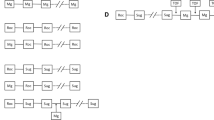Abstract
In addition to its direct effects on blood vessels, the myocardium, and neuromuscular junctions, magnesium can act as an adrenergic antagonist and can inhibit the release of catecholamines both from adrenergic nerve terminals and from the adrenal medulla. This study was undertaken to evaluate these effects of magnesium on muscle relaxation and cardiovascular response during tracheal intubation. Forty ASA I or II patients undergoing elective surgery were allocated to a magnesium or a control group. Three minutes after priming with vecuronium 0.015 mg·kg−1, the magnesium group received vecuronium 0.085 mg·kg−1 and magnesium sulfate 40 mg·kg−1, while the control group received an equivalent volume of vecuronium and saline. The percent change from baseline in mean arterial pressure after tracheal intubation was significantly smaller (P<0.01) in the magnesium group than in the control group, but the percent change in heart rate was similar. There were no significant changes in plasma catecholamine concentrations after tracheal intubation in either group. The onset time of vecuronium was significantly shorter in the magnesium group than in the control group. The duration of action of vecuronium was significantly longer in the magnesium group than in the control group. Serum magnesium concentrations at 90 min after its administration were significantly higher than baseline. We concluded that vecuronium priming with magnesium pretreatment inhibits the hypertension associated with tracheal intubation and shortens the onset time of vecuronium, but prolongs it duration of action.
Similar content being viewed by others
References
Baster SJ (1993) Pharmacology of neuromuscular blocking agents. In: Rogers MC, Tinker JH, Covino BG, Longnecker, DE (eds) Principles and practice of anesthesiology. Mosby, St. Louis, pp 1518–1540
Davison KL (1989) A comparison study of vecuronium bromide and atracurium besylate for rapid sequence induction. J Am Assoc Nurse Anesth 57:37–40
Aldrete JA (1987) Magnesium physiology and pharmacology in anesthesia. Anesth Rev 14:33–39
Gambling DR, Birmingham CL, Jenkins LC (1988) Magnesium and the anaesthetist, Can J Anaesth 35:644–654
James MF (1992) Clinical use of magnesium infusion in anesthesia. Anesth Analg 74:129–136
Krendel DA (1990) Hypermagnesemia and neuromuscular transmission. Semin Neurol 10:42–45
James MFM, Schenk PA, Veen BW (1991) Priming of pancuronium with magnesium. Br J Anaesth 66:247–249
Zaloga G, Eisenach JC (1991) Magnesium, anesthesia, and hemodynamic control. Anesthesiology 74:1–2
James MFM, Cork RC, Dennet JE (1987) Cardiovascular effect of magnesium sulphate in the baboon. Magnesium 6:314–324
Ghoneim MM, Long JP (1970) The interaction between magnesium and other neuromuscular blocking agents. Anesthesiology 32:23–27
Sinatra RS, Philip BK, Naulty JS, Ostheimer GW (1985) Prolonged neuromuscular blockade with vecuronium in a patient treated with magnesium sulfate. Anesth Analg 64:1220–1222
Jones RM (1989) The priming principle: How does it work and should we be using it? Br J Anaesth 63:1–3
Schwarz S, Illias W, Lackner F, Mayrhofer O, Foldes FF (1985) Rapid tracheal intubation with vecuronium: The priming principle. Anesthesiology 62:388–391
Taboada JA, Rupp SM, Miller RD (1986) Refining the priming principle for vecuronium during rapid-sequence induction of anesthesia. Anesthesiology 64:243–247
Glass PS, Wilson W, Mace JA, Wagoner R (1989) Is the priming principle both effective and safe? Anesth Analg 68:127–134
Heumer GH, Schwarz S, Gilly H, Goettel MW, Plainer B, Lackner F (1995) Pharmacodynamics, pharmacokinetics, and intubation conditions after priming with three different doses of vecuronium. Anesth Analg 80:538–542
Pritchard JA, Cunningham G, Pritchard SA (1984) The Parkland Memorial Hospital protocol for treatment of eclampsia: Evaluation of 245 cases. Am J Obstet Gynecol 148:951–963
James MFM, Cork RC, Dennet JE (1986) Sucoinylcholine pretreatment with magnesium sulfate. Anesth Analg 65:373–376
James MFM, Beer RE, Esser JD (1989) Intravenous magnesium sulfate inhibits catecholamine release associated with tracheal intubation. Anesth Analg 68:772–776
Rasmussen HS (1989) Clinical intravenous studies on magnesium in myocardial infarction. Magnesium 8:316–325
Bertschat F, Ising H, Gunther T, Sorgenfrei J, Wollitz M, Ibe K (1989) Antiarrhythmic effects of magnesium infusions in patients with acute myocardial infarction. Magnes Bull 11:155–158
Hays JV, Gilman JK, Rubal BJ (1994) Effect of magnesium sulfate onventricular rate control in atrial fibrillation. Ann Emerg Med 24:61–64
Sueta CA, Clarke SW, Dunlap SH, Jensen L, Blauwet MB, Koch G, Patterson JH, Adams KF (1994) Effect of acute magnesium administrationon the frequency of ventricular arrhythmia in patients with heart failure. Circulation 89:660–666
Brodsky MA, Orlov MV, Capparelli EV, Allen BJ, Iseri LT, Ginkel M, Orlov YSK (1994) Magnesium therapy in new-onset atrial fibrillation. Am J Cardiol 73:1227–1229
Iseri LT, Allen BJ, Brodsky MA (1989) Magnesium therapy of cardiac arrhythmias in critical care medicine. Magnesium 8:299–306
Iseri LT (1990) Role of magnesium in cardiac tachyarrhythmia. Am J Cardiol 65:47K-50K
James MFM, Cork RC, Harlen GM, White JF (1988) Interactions of adrenaline and magnesium on the cardiovascular system of the baboon. Magnesium 7:37–43
Author information
Authors and Affiliations
About this article
Cite this article
Nishiyama, M., Yanbe, Y. Effects of pretreatment with magnesium on muscle relaxation and cardiovascular responses in tracheal intubation using the priming principle for vecuronium. J Anesth 11, 18–21 (1997). https://doi.org/10.1007/BF02479999
Received:
Accepted:
Issue Date:
DOI: https://doi.org/10.1007/BF02479999




